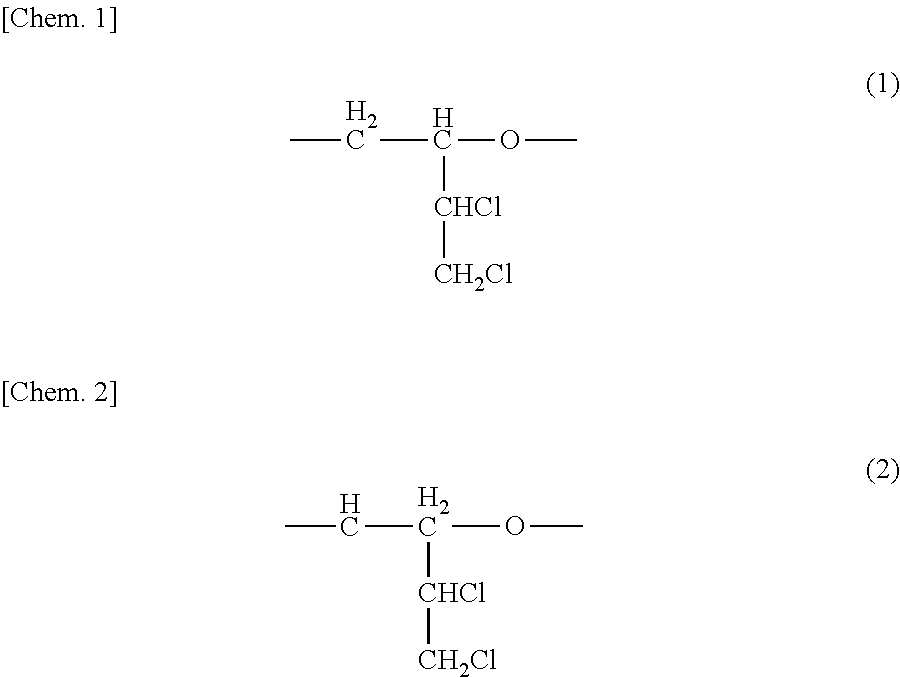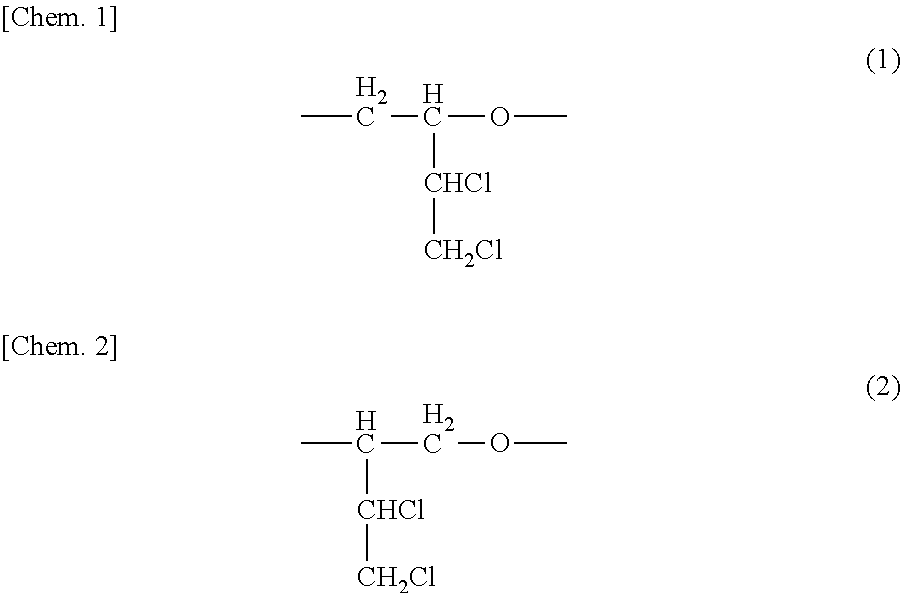Chlorinated polyether and polyurethane obtained therefrom
a chlorinated polypropylene glycol and chlorinated polyether technology, applied in the field of chlorinated polyether and polyurethane obtained therefrom, can solve the problems of poor thermal stability of chlorinated polypropylene glycol, decrease in heat-insulating performance and dimensional accuracy of foam, and difficulty in using such slab products for heat insulation, etc., to achieve excellent thermal stability, improve the adhesion of coating materials, inks and adhesives
- Summary
- Abstract
- Description
- Claims
- Application Information
AI Technical Summary
Benefits of technology
Problems solved by technology
Method used
Image
Examples
examples
[0045]The invention will be explained below by reference to Examples, but the Examples should not be construed as limiting the invention in any way.
[0046]
[0047]Determination of Molecular Weight
[0048]A gel permeation chromatograph (GPC) [(trade name) HLC 8020 GPC, manufactured by Tosoh Corp.] was used together with TSKgel GMHHR-L (trade name; manufactured by Tosoh Corp.) as a column and tetrahydrofuran as a solvent to obtain an elution curve at 40° C. Molecular weight was determined from the elution curve through a calculation for standard polystyrene.
[0049]Examination for NMR Spectrum
[0050]A nuclear magnetic resonance spectrophotometer [(trade name) GSX 270WB, manufactured by JEOL Ltd.] was used to make a measurement using deuteration chloroform as a deuteration solvent.
[0051]Measurement of Thermal Decomposition Temperature (TG / DTA)
[0052]An apparatus for both differential thermal analysis and thermogravimetry [(trade name) TG / DTA 6200, manufactured by SII Nano Technology Inc.] was u...
production example
Production of 3,4-Dichloro-1,2-epoxybutane
[0053]Into a 5-liter four-necked flask equipped with a stirrer, condenser, thermometer, and nitrogen introduction tube were introduced 1,000 g (4.06 mol) of 70% m-chloroperbenzoic acid and 1,360 mL of chloroform. The resultant mixture was stirred to dissolve the m-chloroperbenzoic acid. Subsequently, 426 g (3.44 mol) of 3,4-dichloro-2-butene was added, and this mixture was subjected to reaction at 40° C. for 24 hours. Thereafter, the slurry solution was filtered, and the chloroform in the filtrate was removed with an evaporator to obtain a crude 3,4-dichloro-1,2-epoxybutane product. The crude 3,4-dichloro-1,2-epoxybutane product was distilled at a reduced pressure to obtain 335 g of purified 3,4-dichloro-1,2-epoxybutane.
example 1
[0054]A 200-mL four-necked flask equipped with a stirrer, thermometer, and nitrogen introduction tube was heated and dried at a reduced pressure, and nitrogen displacement was conducted. Thereafter, 2.7 g (36 mmol) of propylene glycol as a polymerization initiator, 0.52 g of a boron trifluoride / ether complex as an acid catalyst, 30 g of methylene chloride as a polymerization solvent, and 30 g (214 mmol) of the 3,4-dichloro-1,2-epoxybutane obtained in Production Example were introduced thereinto, and polymerization reaction was conducted for 1 hour while stirring the mixture on an ice-water bath.
[0055]Subsequently, 25 mL of 1% aqueous sodium hydroxide solution was added, and the resultant mixture was stirred for 30 minutes. After the reaction mixture was subjected to oil-water separation, the organic layer was dried with anhydrous sodium sulfate. The anhydrous sodium sulfate and the methylene chloride were removed to thereby obtain 31 g of a viscous liquid. In 1H-NMR analysis, the pr...
PUM
| Property | Measurement | Unit |
|---|---|---|
| temperatures | aaaaa | aaaaa |
| temperature | aaaaa | aaaaa |
| weight loss temperature | aaaaa | aaaaa |
Abstract
Description
Claims
Application Information
 Login to View More
Login to View More - R&D Engineer
- R&D Manager
- IP Professional
- Industry Leading Data Capabilities
- Powerful AI technology
- Patent DNA Extraction
Browse by: Latest US Patents, China's latest patents, Technical Efficacy Thesaurus, Application Domain, Technology Topic, Popular Technical Reports.
© 2024 PatSnap. All rights reserved.Legal|Privacy policy|Modern Slavery Act Transparency Statement|Sitemap|About US| Contact US: help@patsnap.com










